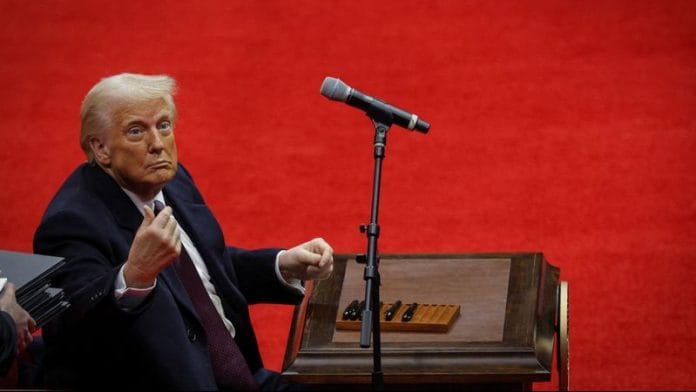The Bard of Avon’s words about human ingratitude and harsh winds—“Blow, blow, thou winter wind, Thou art not so unkind, As man’s ingratitude—feel oddly prophetic in the context of Donald Trump’s second term as US President. Deviating from tradition, Trump was sworn in as the 47th President of the United States indoors at the Rotunda of the US Capitol building. The last indoor swearing-in was Ronald Reagan’s, in 1985. This year’s decision was prompted by extreme cold winds outside, with temperatures plummeting to -6 degrees Celsius.
Yet it wasn’t the biting cold that dominated the day—it was Trump’s words and actions that sent chills down the spines of several heads of state internationally and ‘liberal’ cultural Marxist groups domestically.
While ‘liberal America’ ran down all of Trump’s views as Islamophobia, nationalist jingoism, and socialist populism, Trump took a leaf from Franklin D Roosevelt’s April 1932 radio speech in Albany, New York. Roosevelt emphasised restoring faith in the “forgotten man at the bottom of the economic pyramid.” Similarly, Trump vowed to prioritise the interests of poor, working-class Americans in his policies—a message that worked for him in the presidential race.
Also read: Stop feeling bad for Indian illegal immigrants Trump throws out. They chose to leave India
Trump is back, liberals can scorn again
Trump’s inaugural address, marked by a mix of populist rhetoric and bold promises, echoed his campaign themes. He reiterated his resolve to “make America great again” (MAGA) and declared that “the golden age of America begins right now.” He pledged to beat inflation and “rapidly bring down costs and prices.”
While his ‘socialist’ rhetoric resonated with his supporters, liberal groups—huddled in exclusive clubs, coffee shops, and university canteens—were left crestfallen.
This group had succeeded in defeating Trump in 2020, seething at his inaugural speech in 2017, where he declared: “For too long, a small group in our nation’s Capital has reaped the rewards of government, while the people have borne the cost. Washington flourished—but the people did not share in its wealth. Politicians prospered—but the jobs left, and the factories closed.” Four years later, Trump is back to push the liberal cartel further back—quite possibly into oblivion.
But did Trump truly take on the liberal class, or did he use their scorn to consolidate his support among America’s “have-nots”? While he was addressing the majority of his voter base, the guest list at his inauguration told a different story.
The plush Capitol Hill Rotunda was adorned with the high and mighty of American business, including tech industry leaders. Elon Musk, who reportedly spent $300 million supporting Trump’s campaign, was flanked by Mark Zuckerberg, Jeff Bezos, Tim Cook, and Sundar Pichai.
Interestingly, the last time these four tech executives were seen together was during a Congressional hearing on antitrust issues in July 2020. Republican David N Cicilline, chairman of the antitrust panel, had accused them of amassing ill-gotten wealth through potentially anti-competitive practices. “Our founders would not bow before a king. Nor should we bow before the emperors of the online economy,” Cicilline had said.
Other notable attendees included media tycoon Rupert Murdoch, FIFA president Gianni Infantino, leading sports personalities, and celebrities such as YouTube influencers Jake and Logan Paul.
Conspicuously absent from the audience, however, were the very “working-class” Americans Trump claimed to champion.
Also read: There’s a new ‘ism’ in town. Left, Right & Centre are losing to it
The document close to Trump’s heart
The irony of this juxtaposition would not be lost on observers. Even more ironically, though, both Trump-hating liberals and his ardent supporters are unaware of the roadmap he will roll out in the coming months.
It is likely to be an economic project far different from the socialist vision promised in his campaign and inaugural speeches. One should not be surprised if Trump keeps the “Project 2025” report on his Oval Office table and begins drawing inspiration from it. The 900-page policy document was produced in April 2023 by one of Washington’s prime think tanks, the Heritage Foundation, where people considered close to Trump argue: “It’s not 1980. In 2023, the game has changed. The long march of cultural Marxism through our institutions has come to pass.”
The document was denounced by Democrats, who launched a “Stop Project 2025 Task Force”, forcing Trump to publicly distance himself from it. But the policy blueprint has clearly influenced his vision. The document’s four key goals are: restoring the family as the centrepiece of American life; dismantling the administrative state, defending national sovereignty and borders, and securing God-given individual rights to live freely. All of these themes were present in Trump’s inaugural speech.
Much like the think tank’s first policy document, crafted for Ronald Reagan in 1981, the ‘Project 2025’ report frames the challenges facing America as ideological battles against socialism and cultural elites. It asserts: “In 1979, the threats we faced were the Soviet Union, the socialism of 1970s liberals, and the predatory deviancy of cultural elites. Reagan defeated these beasts by ignoring their tentacles and striking instead at their hearts.” Trump’s 20 January 2025 declarations echo a similar combative tone.
Ultimately, Trump’s second term raises the same question that defined his first: will his presidency deliver on the promises of economic reform and support for the working-class Americans, or will it serve the interests of the elite present at his inauguration? Liberals, cultural Marxists, Left-wing groups, and immigration apologists—call them what you will—now have to survive four more years of Trump’s onslaught to mainstream their agenda once again.
Seshadri Chari is the former editor of ‘Organiser’. He tweets @seshadrichari. Views are personal.
(Edited by Prashant)






